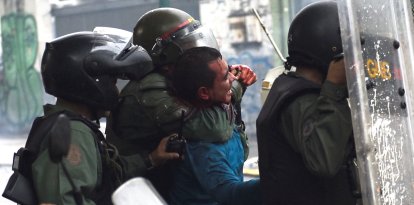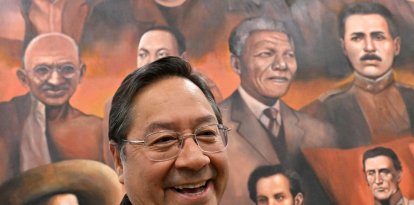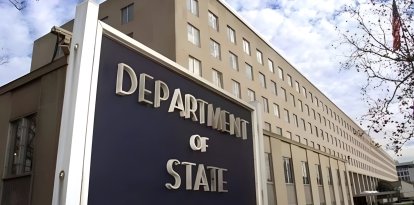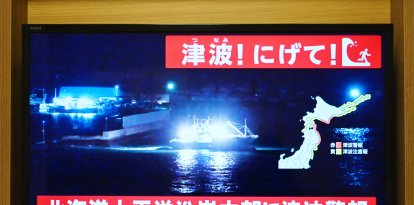Yazidis, the persecuted minority in the Middle East that few people care about
The Yazidis have been subjected to murder, rape and ethnic cleansing by Islamists throughout their history. They are still persecuted to this day but they have never received the support of pro-Palestinian progressives.
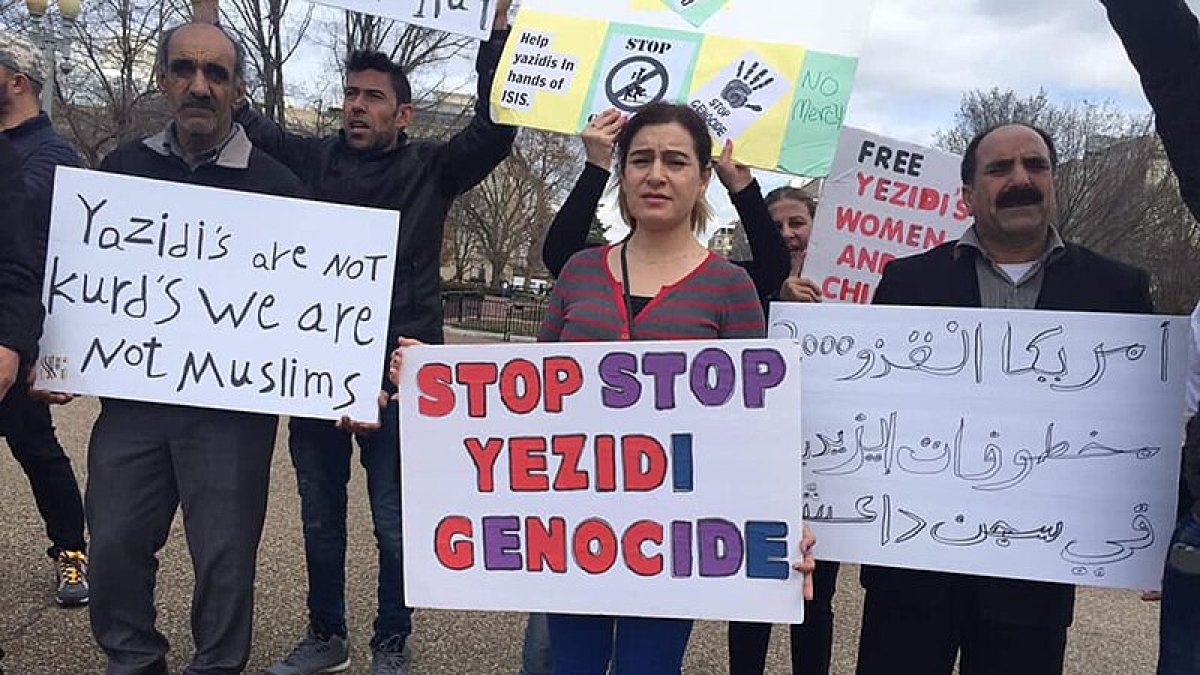
Manifestación yazidí frente a la Casa Blanca en 2019 (Wikimedia Commons)
The Yazidis are followers of a Middle Eastern religion, which they say is even older than Judaism, with roots dating back centuries before the Christian era in ancient Persia and resembles the Zoroastrian faith. The Yazidis have adopted various traditions from Sufi Islam and other Mesopotamian cultures.
Like Muslims, Yazidis pray five times a day. Like the Zoroastrians, they maintain the purity of the four elements (earth, water, air and fire). The members of this community believe that God manifests himself in the human body and also in reincarnation.
Throughout history, the Yazidis have been viewed by their Muslim neighbors as "devil worshipers," so they have had to live constantly on the run. In recent years they have settled between the autonomous region of Kurdistan and the Sinjar and Shekhan mountains, both in the Iraqi province of Nineveh.
The Yazidi community in Iraq has around half a million members, representing less than 2% of the Iraqi population, made up of more than 40,000,000 inhabitants. Other large communities live in exile in Syria, Armenia and Germany.
Journalist Ethel Bonet points out in her book Genocide of the Yazidi People that the sanctuary of Adi ibn Musafir al-Hakkari, also known as the Mecca of the Yazidis, from the 12th century, has served as a refuge for all the members of this community who have been victims of harassment and persecution by the Ottomans, the late former president Saddam Hussein, Sunni fundamentalist groups and terrorist organizations such as Al Qaeda and more recently the Islamic State. This temple was founded by Adi ibn Musafir, whom Yazidism considers an avatar of Melek Taus, the Peacock Angel, who is the central deity in their faith.
The Yazidis consider Malak Taus as the alter ego of God, who is inseparable from him, therefore Yazidism is monotheistic.
Bonet states in her book that after his death, Sheikh Adi was buried in Lalish, where the most sacred shrine of the Yazidis was built, which is visited by pilgrims from Iraq and other parts of the world.
Bonet states in her book that “ethnically, the Yazidi minority is associated with the Kurds since the Yazidis speak the Kurmanji dialect, one of the most widespread among the Kurdish population of northern Iraq and northern Syria," so "they consider themselves to be pure Kurds, while the rest succumbed to the conversion to Islam with the Islamization campaigns starting in the 7th century.”
According to some studies, the number of Yazidis who were killed over the centuries could be as many as 20 million. Despite the persecutions suffered since the Ottoman Empire and so many centuries of martyrdom, they have never lost their faith or their sense of identity.
The persecution of the Yazidis during the Ottoman Empire
During the Ottoman Empire, which lasted from 1299 to 1922, the Yazidis faced several waves of persecution and massacres, especially in the 19th and early 20th centuries. The reasons for these persecutions were partly religious since the Yazidis were considered heretical by Muslim Ottomans, and partly political and social, due to Yazidi resistance to Ottoman authority and their refusal to convert to Islam.
Some of the harshest persecutions were carried out by the Muslim Kurdish princes Bedir Khan Beg (from the Ottoman principality of Bohtan) and Muhammad Pasha of Rawanduz (from the Ottoman emirate of Soran) in the mid-19th century. 1832 was one of the worst years for the Yazidis when some 70,000 members of this community were murdered by both leaders, which today could be considered genocide.
Another tragic event in Yazidi history occurred in 1892 when the Yazidis were attacked by the Ottoman leader Omar Wahbi Pasha, who told members of this community that they must convert to Islam, pay higher taxes or die.
The Yazidis were undeterred and refused to convert to Islam or pay higher taxes so Omar Wahbi Pasha, in alliance with the Muslim Kurds, attacked the Yazidis in the Sinjar and Sheikhan regions, killing thousands of them or forcing them to embrace Islam. The Ottoman leader then attacked Lalish and the tomb of Sheikh Adi, bringing the sacred relics of the Yazidis to Mosul. For the next seven years, the Lalish pilgrimage shrine was used as a Muslim school.
Throughout the Ottoman period, the Yazidis continuously had their land and property taken from them and distributed among Muslims, as part of policies to weaken their autonomy and assimilate them.
2007, a year marked by Yazidi bloodshed
2007 was another year marked by tragedy for the Yazidis. In April, 23 of them traveling on a bus were killed by Kurdish Muslims who stopped the vehicle in northern Iraq.
In August, four trucks driven by Islamists and loaded with explosives blew up in northern Iraq. In the incident, which is known as the Qahtaniyah bombings, 800 Yazidis were killed and another 200 were seriously injured, making it one of the deadliest terrorist attacks in history.
The genocide perpetrated by ISIS against the Yazidis
The most recent massacre the Yazidis experienced occurred in August 2014. According to the Nadia's Initiative's website, well-known Yazidi survivor and activist Nadia Murad claims the world witnessed a genocide. Within two weeks, the Iraqi region of Sinjar was invaded by the terrorist organization Islamic State (ISIS), which undertook a campaign to carry out ethnic cleansing against the Yazidis.
The foundation adds that approximately 400,000 Yazidis fled to the neighboring Iraqi Kurdistan region and tens of thousands took refuge on Mount Sinjar, where they were on the brink of famine. The rest, unable to flee, were killed or kidnapped and subjected to horrible acts of violence: slavery, forced labor, torture and rape. It is estimated that ISIS killed 5,000 Yazidi men and women.
According to Nadia's Initiative’s website, it came about because ISIS considered the Yazidis “infidels” and forced the men to convert to Islam or die. Women, on the other hand, had no choice. They were kidnapped, forced to marry the highest bidder, sexually enslaved, and forced to convert to Islam.
The foundation points out that ISIS captured more than 6,000 women and children and almost 2,800 are still missing today. It adds that sexual violence was used strategically as a weapon of war and the terrorist group's manuals explained how to traffic Yazidi women. Furthermore, ISIS believed that rapes would destroy the community from within.
Genocide continues to this day
Nadia's Initiative confirms that the consequences of the genocide continue to affect the Yazidi community to this day. The foundation states that genocide is not a singular event but a process of marginalization, violence and deprivation of resources.
ISIS did not limit itself to destroying the lives of the Yazidis but also to dismantling agricultural lands and basic resources to prevent the community from returning to settle in the area again.
The foundation clarifies that even though ISIS was defeated in 2019 by an international coalition, the genocide against the Yazidis has not yet stopped.
The story of Nadia Murad, the Nobel Peace Prize winner who survived genocide
Nadia Murad is a Yazidi human rights activist and the 2018 Nobel Peace Prize winner. The 31-year-old woman has become the voice of the survivors of the genocide and sexual violence suffered by their community. She travels around the world teaching others about the history and suffering of the Yazidis.
In 2014, ISIS attacked her homeland in Sinjar to carry out ethnic cleansing. The terror group wanted to remove all Yazidis in Iraq, according to the foundation's website. It adds that like many minority groups, members of his community have borne the weight of historical persecution. Women, in particular, have suffered greatly as victims of sexual violence.
Nadia managed to escape from captivity after three months of being sold as a sexual slave to different men.
In an interview with the Israeli newspaper Maariv in 2018, Murad said she no longer thinks about what happened to her but rather what could be happening to the other women who stayed there. “It is impossible to erase the scenes of rape of women and girls from memory, some of whom even had abortions; of the separation of babies from their mothers and the brutal rape of minors.”
Regarding her captivity, Murad said: "They prayed and then they raped us." (...) They murdered people they considered infidels. In fact, most of the crimes were committed against Muslims who did not believe in their path.”
Murad said she once tried to flee but failed, but was later able to escape while being transported by a driver who worked for ISIS. “I arrived at the home of a Sunni Muslim family in Mosul. The man contacted my brother, who was in a refugee camp in the Kurdistan-Iraq region,” she said. She added that her brother sent money to the man so he could help her. That man issued her an identity document as if she were his Muslim wife and then managed to sneak her out of there.
And the progressive protests defending the Yazidis?
In light of the continued and forceful protests against Israel for its counteroffensive against the terrorist organization Hamas after the October 7 massacre, one cannot help but wonder where were all those progressive protesters. Why weren't they defending the Yazidis?
While it is understandable why Islamists do not hold protests against other Islamists, perhaps the progressives who often accompany them at pro-Palestinian demonstrations should explain why they prefer to look the other way at the atrocities committed against the Yazidis.
In fact, Yazidis tend to feel very identified with the Jewish people. due to the persecution they have been subjected to in the past. Currently, they continue to identify with them and with Israelis in general, since they are victims of Islamist terrorism just as the Yazidis are. However, Israel is a strong state that has always been able to defend itself forcefully.
The Yazidis have never managed to obtain not even a tiny bit of the support and visibility that the Palestinians have had, even though the Yazidi community has not committed any massacres or attempted to carry out ethnic cleansing or genocide. On the contrary, they have been victims of all these crimes.
The Yazidis need the international community's support to rebuild their communities in peace and security. To do this, all those who strongly support the Palestinian cause need to realize that other groups need their support. They shouldn't just focus on the conflicts involving Israel.













